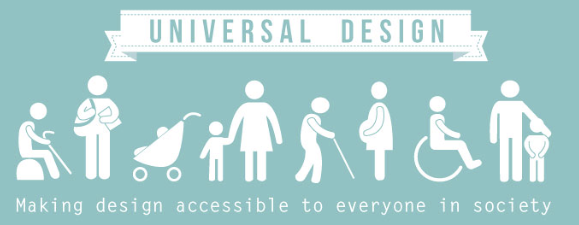Universal Design involves designing products and spaces so that they can be used by a wide range of people and goes further by recognizing that there is a wide spectrum of human abilities. Everyone passes through childhood, periods of temporary illness, injury and old age. By designing for this human diversity, we can create things that will be easier for all people to use. (http://www.universaldesign.com/about-universal-design.html)
In its simplest sense, it is the design of products and environments to be usable by all people, to the greatest extent possible, without the need for specialized designs.
However, it might be simple in its premise but more complicated in practice. Thus, this paper aims to discuss about the statement of Adelson from a magazine read online entitled “Universal Design: Opening Every Door” and relate it to the existence and status of Universal Design in the Philippines.
According to Adelson (2004), Universal Design enables everybody-not just people with disabilities-to navigate, manipulate, and appreciate the world. It makes products, communications, and the built environment not only aesthetically pleasing but also more usable by more people-at little or no extra cost. There’s just one little problem: Universal Design is not exactly universal. Not yet. If it were, many special accommodations for people with disabilities would disappear. They wouldn’t be needed.
In the Philippines, the awareness about universal design is minimal. There are laws and guidelines that aim to give equal opportunities to people with disabilities to maximize their capacity to navigate around a given environment. Some of which are the Batas Pambansa Bilang 344 Accessibility Law, Republic Act No. 7277 Magna Carta for the Disabled Persons and the likes, however, only a few abide with the rules and is barely reflected in the structures. Some designers pave way to follow them, nonetheless, sacrifices and compromises the aesthetic qualities of the design.
Quoting Kwan, the BP 344 and its IRR first published by the Official Gazette in 1984 by the National Commission Concerning Disabled Persons in the Philippines is a comprehensive document; however, enforcement was a major issue from the inception of the Law, and today very few of the concepts implied in the Accessibility Law is actually translated into reality. (Kwan, 2005)
According also to Imrie and Hall (2001), in the Philippines, access legislation has been framed in a context where, as the UN argues, the awareness of the needs of disabled and the elderly at the local level is very minimal. The ineffectiveness of access codes and statutes in the Philippines is due to their disregard by those “in the private sector and government”.
In other Asian countries like Hong Kong, Universal accessibility is gradually improving. The statutory requirements on disabled access have been in force since 1984. Such requirements were revised to provide barrier free access to buildings in 1997. Furthermore, the Disability Discrimination Ordinance, which came into operation in 1996, gives the legal reasons for the people with disabilities to fight for equal opportunities and against discrimination. (Universal Accessibility Best Practices and Guidelines Hong Kong 2004)
According to Kwan (2004), In Hong Kong, both the Disability Discrimination Ordinance and the Equal Opportunities Commission was respectively enacted and established in 1996. It can be regarded that both these instruments made significant contributions towards facilitating access in Hong Kong in terms of the built environment, transportation, accommodation, education, employment, services, etc.
Likewise, in Singapore, the relevant authorities are also targeting at more innovative and friendly design to improve usability and livability for everyone. It is the intention of the Building and Construction Authority (BCA) to instill awareness among designers and building owners/developers who have the influence to cater for the full range of human needs and be sensitive to incorporate them in the design. Singapore, being a small island state has placed great emphasis on its planning to ensure the efficient use of the limited resources. The 2001 Concept Plan of Singapore envisioned to develop Singapore towards a thriving world-class city in the 21st century. It establishes the strategies to develop Singapore into a dynamic city, a distinctive city and at the same time a delightful city. At the implementation level, BCA envisions a built environment that incorporates universal design and will transform Singapore into an accessible and user-friendly city for all. (Building and Construction Authority. (2006) Universal Design Guidelines. Singapore)
To encourage designers and planners in Hong Kong and Singapore to apply the guidelines and laws in Universal Design, some initiatives that their Building Administration has done was to acknowledge the best practices and guidelines through photographs, creating galleries and even gave awards and prizes to buildings for compliance, even the people involved in the design process, so that other designers will emulate these practice.
In conclusion, the researcher agrees with Adelson that Universal Design is not yet universal especially in the local Philippine setting. In Asia alone, the Philippines is being left out in terms of implementation of Universal Design by other ASEAN countries like Hong Kong and Singapore to which it is already included in their Concept Plan and has created guidelines for its enforcement. To address this issue, the Public Private Partnership (PPP) Program of the Philippines should be encouraged to play a key role in the implementation of Universal Design that can somehow be included in the Philippine Development Plan to obtain a higher standard of Universal Design in the country. Likewise, the local Filipino architects and planners still need to instill a deeper sense of sensitivity towards inclusive design by reviewing and updating the existing laws and guidelines with the aid of the Local Government Units through the participation and pioneering act of the United Architects of the Philippines and even the allied services in the built environment sector such as landscape designers, interior designers, surveyors, engineers, etc. to carefully and intently include it in the design implementation and program initiatives of any given structure to better address the needs of all people from all ages and different abilities especially those who are physically challenged to give them equal opportunities, experience and have ease of access without compromising the aesthetics and design quality of the building and its built environment.
References:
Adelson, R. (Oct-Dec 2004). Universal Design: Opening Every Door Inside MSS, 4, 30-34 Retrieved from http://search.proquest.com/docview/215864701?accountid=36184
Building and Construction Authority. (2006) Universal Design Guidelines. Singapore
Kwan, J.(May-Aug 2005). Architecture for All- Part 1, 42, 20-24.
Architectural Service Department. (2004) Hong Kong Universal Accessibility Best Practices and Guidelines
Imrie, R. & Hall, P. (2001). Inclusive Design. Designing Accessible Environments. Spon Press 11 New Fetter Lane, London
What is Universal Design? (2015). Retrieved May 23, 2015, from http://www.universaldesign.com/about-universal-design.html

